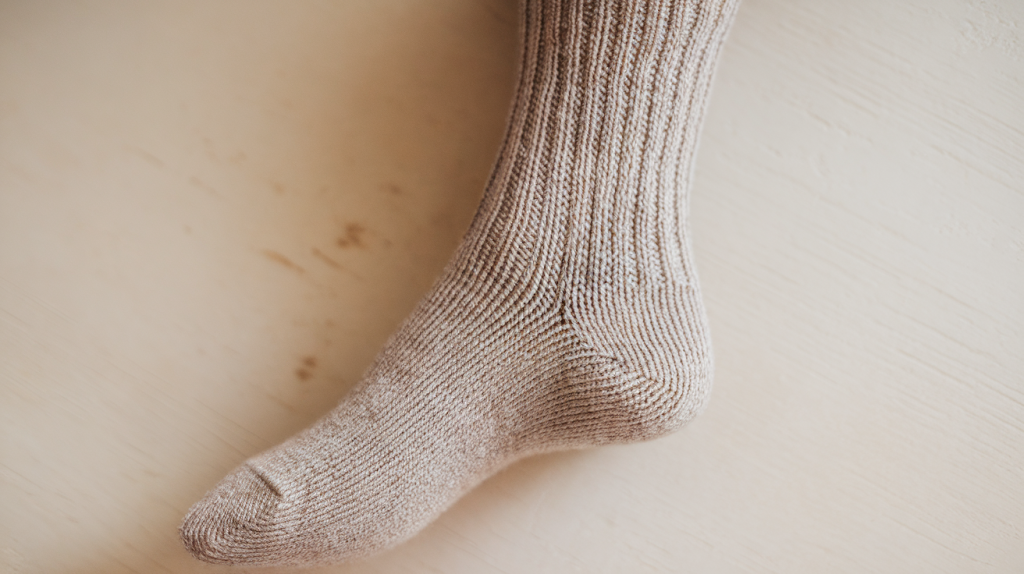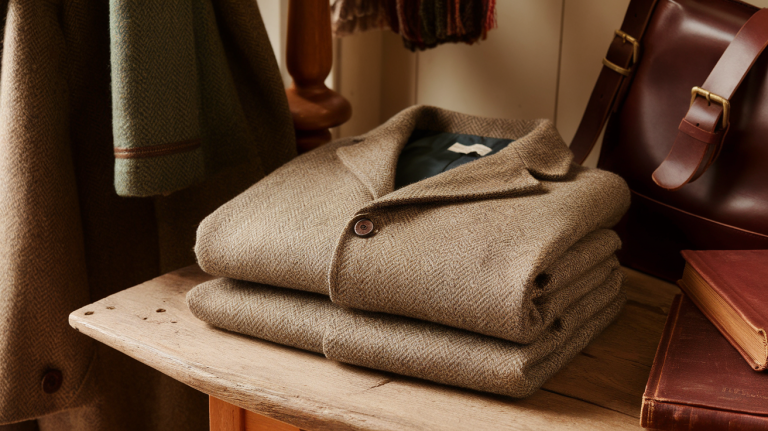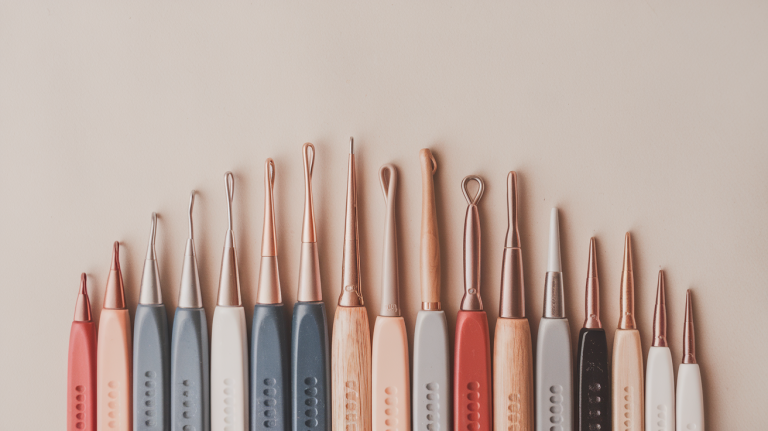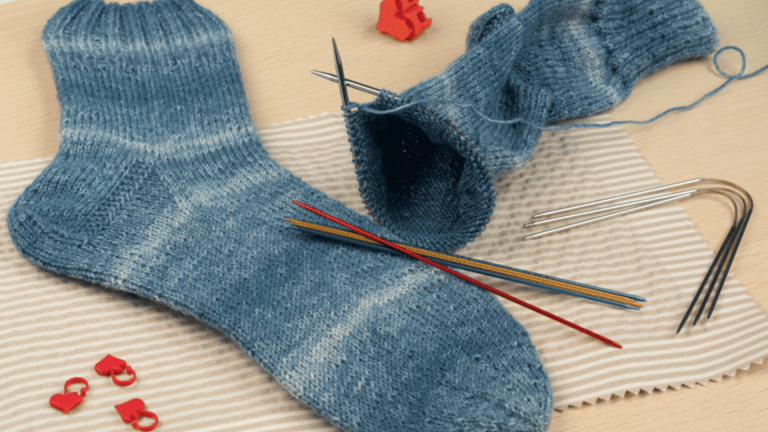The French heel is a classic knitting technique used in cuff-down socks to create a well-shaped and comfortable heel.
It features a V-shaped turn that provides structure while ensuring a snug fit. Many knitters prefer this method because it balances durability with a neat appearance. This heel type works well for high insteps by adding extra depth before decreasing in the gusset.
The shaping process uses short rows and decreases, which help the sock fit naturally around the heel and ankle. Understanding how to knit a French heel can improve the overall fit and look of your socks.
This guide will explain how the French heel is constructed, its benefits, and when to use it for your next sock project.
What Is French Heel Knitting?
French heel knitting is a technique used in cuff-down socks to create a well-shaped and comfortable heel.
It is known for its V-shaped turn, which provides structure while maintaining a flexible fit. This heel construction allows the sock to mold naturally to the foot, offering both support and comfort.
One of the key benefits of the French heel is its ability to accommodate high insteps. It adds extra depth before the gusset decreases, ensuring a better fit for those needing more ankle space.
The shaping method combines short rows and decreases, which help form a heel that balances durability and flexibility. This heel type works well for various sock designs, from simple patterns to intricate textures.
Its structured yet smooth shape makes it a great option for knitters looking for a classic and well-fitted sock heel.
Why Choose the French Heel?
The French heel is adaptable and works well for different foot shapes and sock styles. It is especially popular for knitters who want a clean and structured finish.
- Neater fit than the Dutch heel: The shaping of the French heel creates a more refined and tailored look compared to the Dutch heel, which has a boxier shape.
- Balanced and deep heel structure: The French heel offers a deep and well-fitted heel cup that ensures comfort while maintaining structure.
- Uses short rows and decreases for shaping: This method helps create a smooth and even transition from the heel flap to the foot.
- Works for both plain and patterned socks: Whether knitting a simple sock or a design with cables and lace, the French heel maintains a clean and professional appearance.
This heel type is a great choice for knitters looking for a structured heel with a good fit that works across different sock patterns. It provides a comfortable shape, making it a reliable option for everyday wear.
Materials and Tools Needed
You need the right materials to knit a French heel to ensure a smooth and well-fitting result. Choosing the correct tools and supplies helps create a strong, long-lasting sock that maintains its shape over time.
Yarn and Needles
The yarn should match the intended sock gauge, ensuring a proper fit. Most sock patterns use fingering or sport-weight yarn with small needles to create a firm fabric that lasts longer.
A tighter gauge helps prevent excessive stretching and increases durability, making the socks last longer with regular wear.
Stitch Markers
These help track decreases in the gusset and ensure the stitches stay aligned throughout the heel construction.
Stitch markers can also be placed at key points to keep track of the center of the heel, helping maintain symmetry during shaping.
Knitting Pattern or Heel Calculator
A pattern or heel calculator helps adjust the stitch count for the heel based on the size and shape of the sock. This ensures the heel fits well without being too tight or loose.
Using a calculator or following a structured pattern helps knitters avoid common sizing mistakes, making it easier to create perfectly fitting socks.
Having the right materials and tools makes the knitting process easier and helps create a well-shaped and durable French heel.
Proper preparation allows knitters to work through each step confidently, resulting in a comfortable and well-fitted sock that provides support and flexibility.
Step-by-Step Guide to Knitting a French Heel
The French heel is built in a series of steps that shape it and ensure a comfortable fit. Each stage contributes to making the sock both supportive and durable.
Knit the Heel Flap
The heel flap is worked back and forth on half of the total stitches. This section reinforces the heel, adding strength to an area that experiences frequent wear.
Many knitters use slip-stitch patterns to create a textured fabric, making the heel more durable. The flap should be long enough to provide good coverage but not too long, as it affects the final fit of the sock.
Turn the Heel
This step shapes the base of the heel by decreasing stitches at the center. Short rows are worked in a way that forms a V-shaped or trapezoidal structure, allowing the sock to curve around the foot.
The decreases create a snug fit while maintaining flexibility, preventing the heel from feeling too tight.
Pick Up Stitches for the Gusset
After the heel turn is completed, stitches are picked up along the edges of the heel flap. This step connects the heel to the rest of the sock and ensures a smooth transition to the foot section.
The number of stitches picked up depends on the length of the heel flap. Picking up stitches evenly is key to avoiding gaps along the sides.
Gusset Decreases
Once the stitches are picked up, decreases are worked in alternating rows to shape the gusset. The purpose of the gusset is to merge the extra stitches from the heel flap back into the main part of the sock, creating a smooth and fitted look.
Decreasing too quickly can make the sock too tight, while decreasing too slowly can result in excess fabric. Balancing the decreases ensures a comfortable fit.
Each of these steps contributes to the structure of the French heel, making it a great choice for sock knitting.
The combination of a deep heel cup, reinforced flap, and structured gusset makes it both practical and comfortable.
For a more visual and detailed guide, see this YouTube Tutorial by @knitjoy
French Heel vs. Other Heel Types
Different heel constructions provide unique fits and shaping methods. The French heel stands out due to its structured design, which balances flexibility with support.
Comparing it to other heel types helps knitters understand the benefits of each method.
| Aspect | French Heel | Dutch Heel | Short-Row Heel | Afterthought Heel |
|---|---|---|---|---|
| Appearance | Elegant, narrow heel that tapers gradually from the back | Heel created by knitting short rows, often with a rounded look | The heel is created by working short rows to shape the foot | The heel is added after the main sock is knitted, inserted later |
| Knitting Technique | Typically knitted with a gradual slope from the back of the sock | Knit using short rows that form a curved shape for a better fit | Uses short rows to form the heel without a gusset | Created after knitting the sock, attached where the heel is needed |
| Comfort | Generally comfortable with a smooth, gentle fit | Offers a custom fit around the heel and is more comfortable | Provides a good fit, especially for high arches | Provides flexibility since it’s added at the end, customizable |
| Stability | Offers moderate support but less than other styles | Great stability with the custom short-row shaping | Moderate support, adapts well to foot shape | Moderate stability, custom fit based on final placement |
| Best For | Vintage or classic sock styles, formal wear | Ideal for a snug, custom fit in socks or shoes | Best for socks requiring a tailored fit | Perfect for when you need to add a heel after the sock is completed |
| Common Materials | Yarn, typically wool or cotton for socks | Yarn, typically wool or cotton | Yarn, typically used in knitting socks | Yarn, typically wool or cotton, is added after completing the sock body |
| Suitability | Great for elegant and classic socks | Ideal for socks that need a custom heel fit | Works well with socks for a personalized fit | Suitable for knitters who want to add a heel after completing the rest of the sock |
Each heel type serves a different purpose, depending on the desired fit and design. The French heel is ideal for those looking for a balance of comfort, structure, and durability in their socks.
When to Use the French Heel
The French heel is a great option for knitters looking for a structured and well-fitted sock heel. It is commonly used in cuff-down sock patterns, making it ideal for those following traditional knitting methods.
Since this heel provides a deep and contoured shape, it offers extra comfort and flexibility for different foot shapes. This heel works especially well for people with high insteps.
The design allows for added depth before the gusset decreases begin, ensuring a better fit around the ankle and arch.
Unlike some heel types that may feel tight, the French heel provides enough room without being too loose.
It is also a good option for traditional and vintage-inspired sock designs. Many classic sock patterns feature this heel construction because it balances durability and comfort.
Whether knitting simple everyday socks or more intricate designs, the French heel helps create a clean and well-shaped result.
Common Mistakes and How to Avoid Them
Knitters may face a few common challenges when working on the French heel. Attention to these details can help achieve a better fit and a smoother knitting experience.
Uneven Tension
Keeping an even tension throughout the heel construction is important. Stitches that are too tight can make the heel stiff, while stitches that are too loose may cause gaps or holes.
To maintain even tension, practice knitting heel flaps and turning the heel on a swatch before working on a full sock. Avoid pulling the yarn too tightly when working short rows, as this can make the heel uncomfortable to wear.
Skipping the Heel Turn Shaping
The heel turn is necessary to shape the sock and allow it to mold around the foot. Skipping this step may result in a heel that does not sit properly or lacks depth.
Carefully follow the instructions for short-row decreases to achieve the correct heel cup shape. If the heel feels too shallow, add a few extra rows to create more depth.
Misaligned Gusset Stitches
The gusset helps transition the heel to the foot, and misaligned stitches can cause an uneven fit. Use stitch markers to track decreases and ensure that both sides of the gusset have the same number of stitches.
If gaps appear where stitches were picked up along the heel flap, try picking up one extra stitch and decreasing it in the next round to create a neater edge.
Incorrect Stitch Count After Picking up Gusset Stitches
Picking up to a few stitches can cause tightness in the arch while picking up too many can create an extra fabric that bunches.
Count the stitches carefully before continuing with the gusset decreases to ensure the sock maintains a proper shape.
Uneven Gusset Decreases
Decreasing too quickly can cause a tight fit, while reducing too slowly can leave the extra fabric in the arch. The standard method is to decrease every other row until the original stitch count is restored, keeping the transition smooth.
Attention to these details will help prevent issues and ensure a better overall sock fit. Working carefully through each step will make the process easier and the final result more comfortable and durable.
Practice and Experimentation
Trying the French heel on different sock patterns can help knitters understand how it affects the overall fit.
Each pattern may have slight variations in stitch count and shaping, so practicing with multiple designs allows for better customization. Adjusting stitch counts using heel calculators can help create a custom fit.
By modifying the number of stitches worked in the heel flap and gusset, knitters can tailor the heel to suit different foot sizes and shapes. Experimenting with reinforced stitches can add durability to the heel.
Slip-stitch patterns or double strands of yarn in high-wear areas can make the socks last longer, especially in the heel and toe sections. With practice and adjustments, the French heel can become a reliable and comfortable option for sock knitting.
It provides a well-balanced mix of structure and flexibility, making it a great choice for various sock patterns.
Conclusion
The French heel is a classic and reliable choice for sock knitting, offering a structured fit and extra depth for comfort. It works well for cuff-down sock patterns and is especially useful for high insteps, providing a smooth transition from the heel to the foot.
Its balance of durability and flexibility makes it a preferred option for both simple and detailed sock designs. Knitters who practice the French heel can improve their technique and create well-fitted socks that last longer.
Adjusting stitch counts, reinforcing the heel flap, and maintaining even tension can all enhance the final result. With careful knitting and experimentation, the French heel can become a go-to method for creating comfortable and well-shaped socks.
Frequently Asked Questions
Is the French Heel Better for Certain Foot Shapes?
Yes, the French heel is a great choice for people with high insteps. It provides extra depth before the gusset decreases, allowing for a more comfortable fit around the ankle and arch.
Can I Use the French Heel for Toe-Up Socks?
The French heel is traditionally used in cuff-down sock patterns. While it is possible to modify it for toe-up socks, other heel types, like short-row or afterthought heels, may be easier to work in that direction.
How Do I Prevent Gaps when Picking up Stitches for The Gusset?
Pick up stitches evenly along the heel flap to avoid gaps, and use stitch markers to track placements. If gaps still appear, pick up one extra stitch and decrease it in the next row to create a smooth transition.
What Is the Difference Between a French Heel and A Dutch Heel?
The French heel is more structured and contoured, while the Dutch heel is wider and boxier. The French heel offers a snug fit, while the Dutch heel provides more room in the heel area.
Can I Reinforce the French Heel for Added Durability?
Yes, reinforcing the heel flap with slip-stitch patterns or using a double-stranded method can strengthen the heel. This helps prevent wear and extends the life of the sock.
How Do I Adjust the French Heel for A Custom Fit?
You can modify the stitch count in the heel flap and gusset to suit different foot sizes. Using a heel calculator or making small adjustments in short rows can help achieve the best fit.









